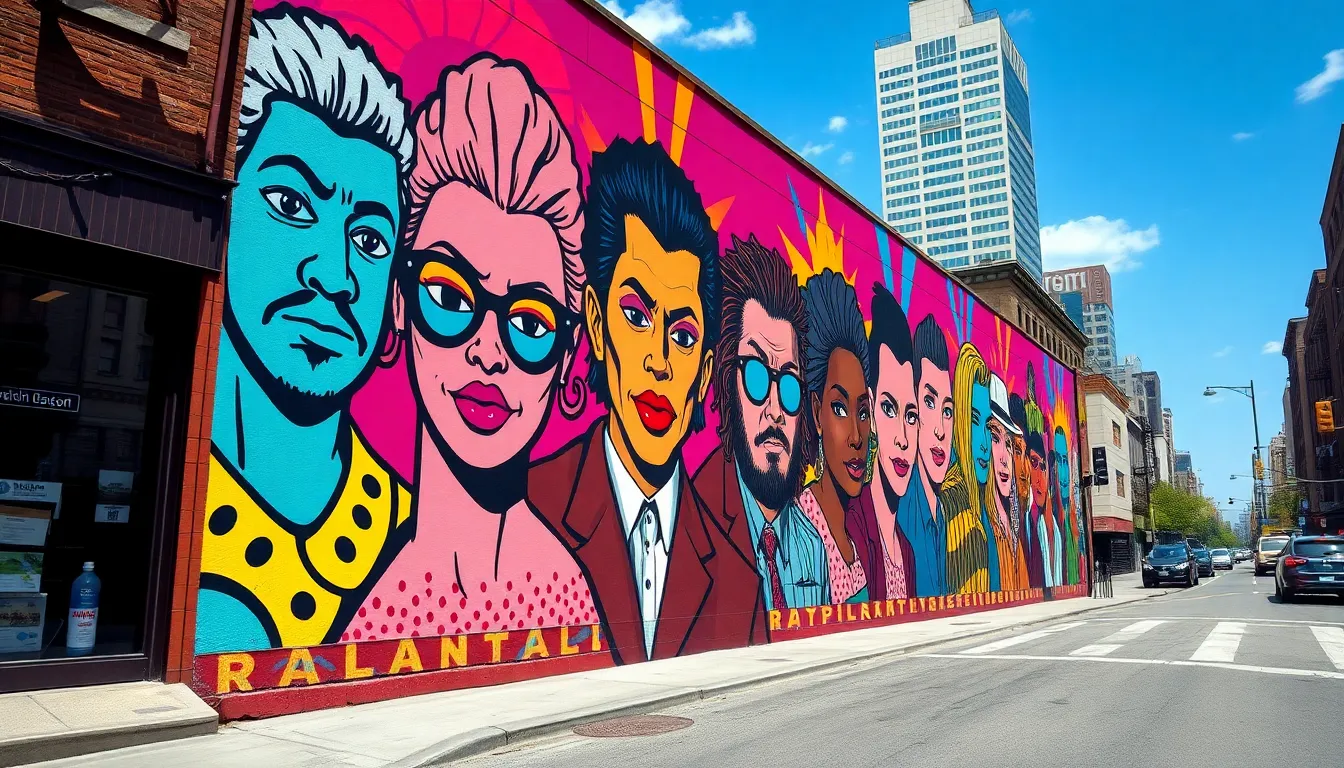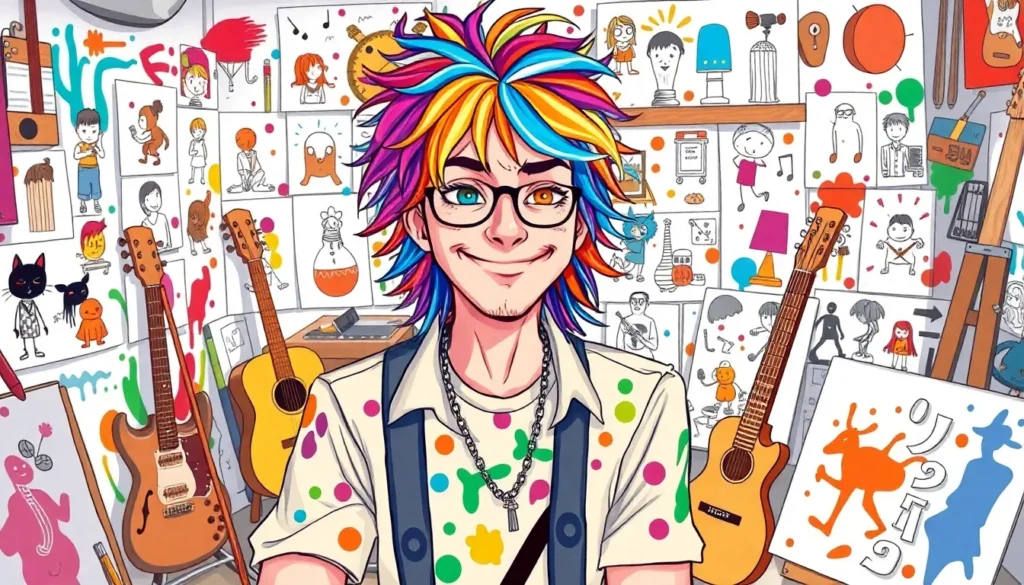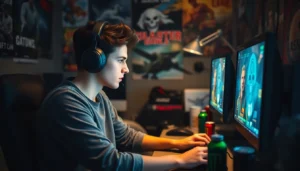In a world buzzing with trends and memes, pop culture artists are the wizards who turn everyday chaos into captivating creations. From quirky illustrations to catchy tunes, these talented individuals shape the way society views itself, often with a cheeky wink and a nod. They’re the modern-day storytellers, weaving humor and relatability into their work, making it impossible not to smile or at least chuckle.
Whether they’re poking fun at the latest celebrity mishap or capturing the essence of a viral dance challenge, their art reflects the pulse of society. Pop culture artists don’t just create; they inspire conversations and ignite movements, reminding us that laughter and creativity are just a brushstroke or a beat away. Dive into the vibrant world of pop culture artists and discover how they’re redefining creativity one meme at a time.
Table of Contents
ToggleOverview of Pop Culture Artists
Pop culture artists shape narratives that resonate with contemporary audiences. Their creations engage with societal issues, often reflecting current events and trends. Utilizing various mediums, they convey messages through striking visuals, music, and performance art. These artists balance humor and critique, enabling them to connect deeply with fans.
In addition, many pop culture artists leverage social media platforms to amplify their reach. Viral content serves as a powerful tool for sharing their work and initiating conversations. Connecting with followers on platforms like Instagram and TikTok allows these artists to cultivate dedicated fan bases.
Moreover, collaboration plays a significant role in defining their impact. By partnering with brands or other creators, pop culture artists expand their influence and reach new audiences. Collaborative projects often generate buzz and bring forth innovative ideas that challenge traditional norms.
Additionally, pop culture artists draw inspiration from diverse sources. They reflect on personal experiences, societal shifts, and cultural phenomena. This eclectic approach ensures their work remains relevant and relatable.
Through their creativity and social commentary, pop culture artists inspire movements and engage audiences across generations. They remind society of the power humor holds in addressing serious topics while fostering a sense of community. The influence of these creators highlights the importance of art in today’s rapidly evolving cultural landscape.
Influential Pop Culture Artists

Pop culture artists shape modern narratives through unique expressions and creativity. Their work resonates deeply, making a significant impact on society.
Iconic Figures in Pop Art
Names like Andy Warhol and Roy Lichtenstein define the pop art movement. Warhol’s vibrant prints of everyday products transformed the perception of commercial art. Lichtenstein used comic strip aesthetics, elevating mundane illustrations into high art. These artists blurred lines between fine art and popular culture, influencing countless creators. Contemporary figures like Banksy and Yayoi Kusama carry this legacy forward. Banksy’s thought-provoking street art criticizes social issues, while Kusama’s whimsical installations invite reflection on mental health and existence. Their contributions highlight the lasting influence of pop culture art.
Emerging Artists to Watch
Several emerging artists capture attention with innovative work. Tyler Mitchell gained recognition as the first Black photographer for Vogue, showcasing diverse narratives in a new light. Artist Shantell Martin uses live drawing and interactive installations to engage audiences creatively. Another noteworthy figure, KAWS, transforms characters from pop culture into collectible sculptures, bridging art and commerce. Genieve Figgis presents surreal, colorful paintings that challenge traditional artistic conventions. These artists exemplify evolving trends, continually shaping the pop culture landscape and sparking dialogue across generations.
Impact of Pop Culture Artists
Pop culture artists significantly influence contemporary culture, serving as vital commentators on societal dynamics. Their unique perspectives create connections between art and everyday life.
Cultural Reflections in Their Work
Art often mirrors cultural trends, and pop culture artists excel at showcasing this phenomenon. Through vivid imagery, energetic music, and relatable themes, they spotlight social issues such as inequality, identity, and environmental concerns. Each piece invites audiences to engage, fostering discussions around prevailing topics. Their ability to encapsulate current moods motivates viewers to reflect on their realities. In this way, artists like Banksy prompt critical conversations that resonate well beyond the gallery, influencing public perception.
Influence on Mainstream Media
Pop culture artists impact mainstream media by reshaping narratives and captivating large audiences. Their work often finds its way into various platforms including television, film, and advertising. Social media amplifies their reach, allowing artists to connect with fans directly. This engagement transforms artistic endeavors into viral sensations, which brands eagerly incorporate into marketing strategies. By leveraging multimedia platforms, they challenge conventional storytelling methods, making culture more accessible. Major media outlets increasingly rely on the innovative ideas of these artists, ensuring their influence continues to grow across diverse audiences.
The Evolution of Pop Culture Art
Pop culture art has undergone significant transformations since its inception. Emerging in the mid-20th century, it combined traditional artistic methods with contemporary themes drawn from everyday life. Artists like Andy Warhol and Roy Lichtenstein infused commercial elements into their work, blurring boundaries between fine art and popular culture.
Current artists build on this foundation, using digital platforms to expand their reach. With social media, they engage interactions with audiences across the globe. Newcomers like Tyler Mitchell and Shantell Martin employ modern techniques that resonate with younger generations. Their distinctive styles often highlight issues like identity and social justice, contributing depth to contemporary pop culture narratives.
Throughout its evolution, pop culture art has remained a reflection of society’s changing dynamics. Artists continuously draw inspiration from cultural phenomena while responding to current events. The vibrant works of KAWS and Yayoi Kusama challenge traditional aesthetic values, encouraging viewers to engage in dialogue.
Furthermore, collaborations between artists and brands illustrate the mutual benefits of this evolution. Successful partnerships lead to innovative projects that captivate audiences and elevate artistic visibility. Pop culture artists influence mainstream media, integrating their creations into television, film, and advertising campaigns.
The ability to comment on social issues and foster discussions sets contemporary pop culture artists apart. They embody the spirit of creativity and community, addressing crucial themes through humor and relatable visuals. In this evolving landscape, pop culture art remains a powerful medium for connection and reflection.
Pop culture artists play a crucial role in shaping modern narratives and engaging audiences through their unique blend of creativity and humor. By addressing societal issues and cultural phenomena, they inspire conversations that resonate across generations. Their ability to leverage social media and collaborate with various brands amplifies their influence and ensures their work remains relevant.
The evolution of pop culture art reflects the dynamic nature of society itself. As these artists continue to push boundaries and challenge norms, their contributions foster a sense of community and encourage reflection on pressing topics. Ultimately, pop culture artists not only entertain but also empower individuals to think critically about the world around them.





